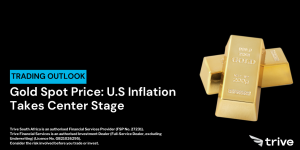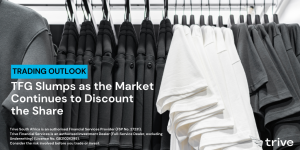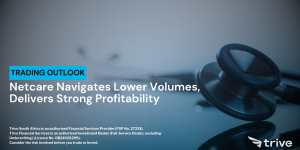
In 2023, Anglo American Platinum Limited (JSE: AMS) encountered substantial challenges, with its share price experiencing a notable decline of over 32% throughout the year. Unfortunately, the beginning of the new year mirrored this trend for the world’s largest platinum producer, as its share price continued to plummet by 24% year-to-date. The latest earnings report failed to meet expectations and did little to instil confidence in a potential recovery.
Total revenue for the year saw a significant drop of 24% to R124.6 billion, while adjusted EBITDA shrank by a substantial 67% from R73.9 billion to R24.4 billion. Headline earnings per share (EPS) plummeted by 71% to R53.30 from R185.42, leading the company to slash its dividend by 81% from R115.00 to R21.30. These disappointing outcomes fell short of analyst predictions and raised concerns regarding the company’s ability to navigate the challenging low platinum group metal (PGM) price environment.
Technical
A descending channel has emerged on the daily chart, with the crossing of the 25-SMA (green line) below the 50-SMA (blue line) confirming the bearish tilt in the shorter term. However, the RSI is nearing oversold conditions and could entice buyers to enter the market if a fundamental shift occurs in the metal market.
Currently, resistance at R729.88 prevents a breakout from a channel. Support is established at R680.71 and could become a level of interest as we advance. Any movement below this support could make the channel vulnerable to a breakdown at R646.87, which could steepen the selloff toward a psychological demand zone at R606.63. Neckline support is established at R579.46 and could come into play in the longer term if the current selling pressure persists.
However, a breakout could be triggered if the price clears the R729.88 level in the upcoming sessions. Resistance at R774.00 could present a significant hurdle, backed by the 25-SMA. While a retracement could kick off at this level, any movement higher could confirm the bullish reversal, bringing the Fibonacci midpoint and 61.8% Fibonacci golden ratio into the equation at R841.05 and R879.03.

Fundamental
From the chart below, it becomes evident that the challenges faced by Anglo American Platinum over the last few years have been industry-wide headwinds. Over the last three years, AMS has shed 58.83% of its price, with its competitors, Sibanye-Stillwater (-70.21%) and Impala Platinum (-71.74%) showing similar declines. These rapid declines happened over the same period that the JSE Top 40 index gained nearly 9%, showing divergence in the metal market from the broader stock market. Suppressed PGM prices drive the industry headwinds, as the prices for Platinum and Palladium have fallen by 36% and 58% over the last 12 months. Significant cost pressures and an uncertain macroeconomic outlook add to the challenges and have forced players such as Sibanye-Stillwater to restructure their operations to reduce operating and capital costs. Similarly, Anglo American outlined its plan to lower production in 2024 to save $1Bn in response to the increased market volatility. After its latest report, the company further stated that it could cut around 3,700 jobs across the business in a restructuring to respond to its recent 71% plunge in profit.

While restructuring is unfortunate, the graph below highlights the need for cost-saving actions to be taken across the business. After its revenue peaked in 2021 at R214.57Bn, the company’s top line has shown a clear downward trend. In contrast, its cash operating costs have increased steadily. As a result, profits have declined, and margins have tightened. Its gross profit margin has fallen from 49% in 2021 to 17%, as its headline earnings attributable to shareholders contracted from R79Bn in 2021 to a mere R14Bn. This divergence between rising costs and a contracting top line could be detrimental in the upcoming years if the business does not find a way to reduce operating costs to keep its margins within the desired range. However, it is worth looking at what is causing the top-line decline, and the most significant driver behind the contraction is the slump in PGM metal prices.

Platinum Group Metal sales comprise over 93% of the company’s revenue. Platinum, Palladium, and Rhodium together constitute around 83% of the top line and have shown significant reductions in value over the last few years, as seen in the chart below. The graph shows the average market prices of these metals achieved over the last five years. Rhodium has shown a massive decline from 2021, when the average price was around $19,613/oz, to $6,592/oz in 2023. Platinum has been the most stable among the group, with its price declining from $1,083/oz in 2021 to $946/oz. Platinum accounts for 38% of group revenue and provides some much-needed stability in the PGM market. Finally, Palladium prices declined from their peak of $2,439/oz to $1,313/oz. Overall, the PGM dollar basket price for 2023 was its lowest since 2019 at $1,657/oz.

While the PGM prices were lower, the drop in revenue was partially offset by a 2% increase in PGM sales volume. On the production front, the company produced 6% fewer PGMs in 2023 at 932,000 ounces, while its annual production fell from 4.02M ounces to 3.81M ounces. For 2024, management expects production to fall between 3.3M and 3.7M ounces, reflecting another decline, while its cost per unit is expected to fall between R16,500 and R17,500 per ounce.
Summary
After a challenging year in 2023, Anglo American Platinum Limited kicked off 2024 on the back foot, as its latest earnings report missed estimates. With ongoing pricing struggles in the PGM market and operating costs increasing, the company faces ongoing challenges in the year ahead. With a proposed restructuring that could affect around 3,700 jobs, progress could be made on the cost-saving side. Still, it remains to be seen whether the metal giant can maintain its falling margins and ignite a recovery in its profit, which slumped by 71% over the last year.
Sources: Koyfin, Tradingview, Reuters, Anglo American Platinum Limited, Moneyweb
Piece written by Tiaan van Aswegen, Trive Financial Market Analyst
Disclaimer: Trive South Africa (Pty) Ltd (hereinafter referred to as “Trive SA”), with registration number 2005/011130/07, is an authorised Financial Services Provider in terms of the Financial Advisory and Intermediary Services Act, 37 of 2002. Trive SA is authorised and regulated by the South African Financial Sector Conduct Authority (FSCA) and holds FSP number 27231. Trive Financial Services Ltd (hereinafter referred to as “Trive MU”) holds an Investment Dealer (Full-Service Dealer, excluding Underwriting) Licence with licence number GB21026295 pursuant to section 29 of the Securities Act 2005, Rule 4 of the Securities Rules 2007, and the Financial Services Rules 2008. Trive MU is authorized and regulated by the Mauritius Financial Services Commission (FSC) and holds Global Business Licence number GB21026295 under Section 72(6) of the Financial Services Act. Trive SA and Trive MU are collectively known and referred to as “Trive Africa”.
Market and economic conditions are subject to sudden change which may have a material impact on the outcome of financial instruments and may not be suitable for all investors. Trive Africa and its employees assume no liability for any loss or damage (direct, indirect, consequential, or inconsequential) that may be suffered. Please consider the risks involved before you trade or invest. All trades on the Trive Africa platform are subject to the legal terms and conditions to which you agree to be bound. Brand Logos are owned by the respective companies and not by Trive Africa. The use of a company’s brand logo does not represent an endorsement of Trive Africa by the company, nor an endorsement of the company by Trive Africa, nor does it necessarily imply any contractual relationship. Images are for illustrative purposes only and past performance is not necessarily an indication of future performance. No services are offered to stateless persons, persons under the age of 18 years, persons and/or residents of sanctioned countries or any other jurisdiction where the distribution of leveraged instruments is prohibited, and citizens of any state or country where it may be against the law of that country to trade with a South African and/or Mauritius based company and/or where the services are not made available by Trive Africa to hold an account with us. In any case, above all, it is your responsibility to avoid contravening any legislation in the country from where you are at the time.
CFDs and other margin products are complex instruments and come with a high risk of losing money rapidly due to leverage. You should consider whether you understand how these products work and whether you can afford to take the high risk of losing your money. Professional clients can lose more than they deposit. See our full Risk Disclosure and Terms of Business for further details. Some or all of the services and products are not offered to citizens or residents of certain jurisdictions where international sanctions or local regulatory requirements restrict or prohibit them.




